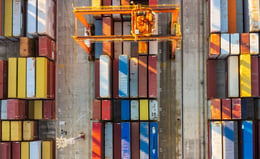How Logistics 4.0 is Changing the Last Mile
Brian Hoey - May 02, 2019

 A few years ago, three days was considered a reasonably quick shipping turnaround. Today, for many consumers three days is considered glacial, two days is considered standard, and only shipping times shorter than one day really count as fast. These changing expectations have put numerous businesses, from manufacturers to logistics providers, in a position to either optimize their transport processes for greater efficiency or cede transportation management as a competitive advantage. The latter is obviously not something that any business really wants, but the former can be a tall order.
A few years ago, three days was considered a reasonably quick shipping turnaround. Today, for many consumers three days is considered glacial, two days is considered standard, and only shipping times shorter than one day really count as fast. These changing expectations have put numerous businesses, from manufacturers to logistics providers, in a position to either optimize their transport processes for greater efficiency or cede transportation management as a competitive advantage. The latter is obviously not something that any business really wants, but the former can be a tall order.
Right now, many of the gains in transport efficiency are coming in the form of improvements to last mile logistics. Where, previously, the last mile was a perennial stumbling block for even the most efficient carriers, an increasingly digitized supply chain (to say nothing of the changing face of labor) has given shippers more options than ever before for bridging that final gap between producers and consumers. Now, while we’re still not quite at the stage where robots and drones can carry out all of our deliveries for us, we’re still seeing an increased level of sophistication when it comes to completing deliveries. We know that this change is being driven, at least in part, by increased customer expectations; but what's making it possible? The simple answer is Logistics 4.0
There’s an App for That
Logistics 4.0 refers to the connected, digitized workflows that are becoming increasingly common in the global supply chain. The concept began as a counterpart to Industry 4.0 (the framework behind the modern smart factory), but it has grown to encompass its own set of ideals and paradigms, from increased supply chain integration (including integration with smart containers, smart pallets, and smart ports), to data-driven insights and increasing digitization. In a typical shipping workflow, Logistics 4.0 processes can decrease the odds of disruptions and slowdowns by providing planners not just with improved forecasts for likely future events, but with a visibility-driven accounting of all of their options for getting goods from point a to point b. But how do these processes impact last mile logistics in particular?
For starters, the increased visibility that Logistics 4.0 promotes helps to make delivery notifications and package tracking much more feasible than it was in the past. Even if you’re using a 3rd party to complete the final leg of your delivery, you can, for instance, equip drivers with a mobile app that tracks package locations via GPS and accepts recipient signatures, sending all of that data straight to your central planning system so that you can notify stakeholders that a particular delivery is in progress or has been completed. This might not sound earth-shattering, but considering that one of the key hurdles that last mile logistics often faces is the difficulty of tracking completed shipments, this simple change has the power to add real value. Once that data is incorporated into your larger planning structures, you can use it to analyze the state of your last mile deliveries—uncovering the exact times of deliveries and thus your rate of on-time deliveries, for instance—and make refinements to your approach.
The “Mobile Warehouse”
In some circles, Industry 4.0 has been described as the Global Factory. Why? Because, it promotes such a high degree of visibility and flexibility across the value chain that the traditional geographic boundaries of manufacturing have become less meaningful. Instead of sourcing all of the necessary resources to create an entire automobile at one plant, planners can divide the job between two disparate facilities and then assemble the finished product at a third location—a process that would have been less than feasible in an environment that provided less direct insight and communication between geographically separate manufacturing facilities. This concept has its parallel in Logistics 4.0 environments, and the last mile is one of the areas that could see the most change as a result.
While traditional logistics tends to rely on physical warehouses and distribution centers to repackage larger shipments into smaller ones as they approach their final destinations, the added visibility and flexibility that are endemic to Logistics 4.0 make it possible to upend this paradigm. Rather than centralizing stock into a warehouse and checking a database for the availability of particular products within that warehouse, IoT sensors and digital loading processes and manifests can give you the same level of insight into the stock that’s currently in transit, meaning that you could conceivably pinpoint the elements of a particular shipment in motion, project their future locations, and arrange a point of consolidation where whatever vehicle is handling the last mile can receive the various elements of the shipment and begin to distribute them. In this way, the entire logistics chain becomes a kind of mobile warehouse. While it may seem like a forbiddingly complex way to administer a supply chain, advanced analytics tools can help planners to pinpoint the optimal ways to move goods into their ideal last-mile configurations.
Network Integration
The scenario we described above might seem a little bit ambitious, but in its way it’s emblematic of other changes that Logistics 4.0 is empowering. Even if you’re retaining a traditional structure of hubs and warehouses, you can still use Logistics 4.0 workflows to integrate your IT with that of your partners and even your customers. Just like the improved system for delivery notifications we saw above (which represents a fairly modest example of this kind of integration), actually sharing data streams via connected IT will lead to better tracking and easier disruption management.
If, for example, you decide to partner with a company that hires out van-owners as independent contractors for the last mile, whatever app they’re using to coordinate their drivers could be linked to your own planning infrastructure. In this way, you can identify the right routes at the right rates in order to maximize your odds of on-time delivery in the most cost effective possible way. As with so much of what we’ve discussed above, added visibility gives you the flexibility and capability you need in order to avoid slow, static, poorly monitored last mile routes and strategies.
LATEST POSTS
- Understand Circular Economy in The Manufacturing Industry
- How Can Industry 4.0 IT Integration Be Achieved Smoothly?
- The Significance of Order Sequencing in Discrete Manufacturing
- How to improve your Supply Chain Management: The Power of Control Towers
- Optimizing Human Resource Scheduling in Manufacturing: A Technological Approach



